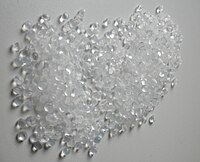
Photo from wikipedia
Abstract Lignocellulosic fibers extracted from sugarcane bagasse were treated with NaOH solutions of different concentration (0-40 wt%) to study the effect of alkali treatment on the composition, structure and properties of… Click to show full abstract
Abstract Lignocellulosic fibers extracted from sugarcane bagasse were treated with NaOH solutions of different concentration (0-40 wt%) to study the effect of alkali treatment on the composition, structure and properties of the fibers. Composition was determined by the van Soest method, structure was characterized by X-ray diffraction (XRD) and scanning electron microscopy (SEM), while mechanical properties by tensile testing. Hemicellulose and lignin content decrease, while cellulose content goes through a maximum as a function of alkali concentration. Crystallinity changes only slightly and microfibril angle (MFA) remains constant thus structural effects and especially MFA are not the primary reasons for changing properties. The Young's modulus of the fibers shows a slight maximum at around 2-4 wt% NaOH content, while tensile strength goes through a much more pronounced one at around 5-8 wt%. Direct correlation between structure and mechanical properties was not found indicating that composition is more important in the determination of properties than structure. Regression analysis proved that the combination of several compositional variables determines mechanical properties in a non-linear manner. The improvement in fiber properties was explained with the dissolution of weak amorphous fractions and the relative increase of cellulose content.
Journal Title: Polymer Testing
Year Published: 2020
Link to full text (if available)
Share on Social Media: Sign Up to like & get
recommendations!